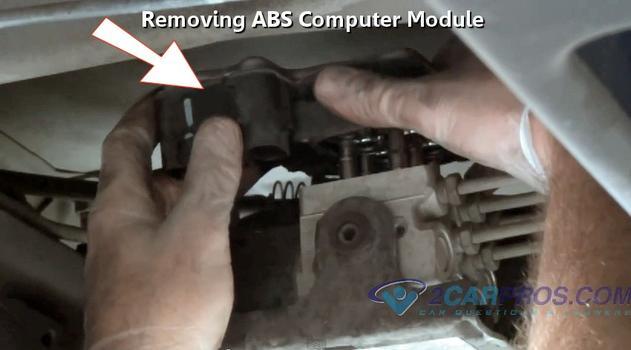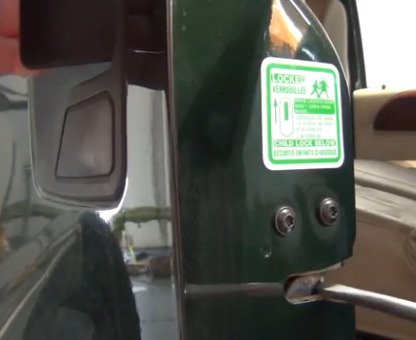You've added a potential frustrating element to the problem by waiting so long. I can offer some suggestions to get us started.
The first order of business is the Anti-Lock Brake Computer detected a problem, set a diagnostic fault code, turned the system off, and turned the yellow warning light on to tell you. You'll need to find a mechanic with a scanner that can access the ABS Computer to read the fault code. Be aware those fault codes never say to replace a part or that one is bad. They only indicate the circuit or system that needs further diagnosis, or the unacceptable operating condition.
Once we know the fault code number, we can figure out where to start. There are dozens of potential causes, but by far the most common one on GM vehicles is loss of signal from one of the front wheel speed sensors. That is due to the design of the sensor, and repeat failures are real common. The sensors develop rather wimpy signals to start with, and they get weaker as vehicle speed gets slower. At first, at real low speeds when slowing down, a signal that "drops out" will make the computer think that tire is skidding. It responds by reducing brake pressure to that one wheel. We call that "false activation". You'll feel that as the characteristic buzzing and / or vibrating in the brake pedal.
Over time the wheel bearing develops a little normal play in it, which happens on all vehicles with this style wheel bearing, but with GM's wheel speed sensor design, the signals drop out at all speeds. The computer sees that missing signal, so it knows it can't operate properly, it turns the system off, and turns the warning light on. The fix for that is a new wheel bearing with the built-in sensor. It is real common for the new wheel bearing to develop the same problem, often in as little as 15,000 miles. The dealers' scrap metal bins are full of these bearings. As a point of interest, the old bearings will work just fine on another vehicle that doesn't have anti-lock brakes. Remember, this is a real common problem, but not the only possible one. Once we know the fault code number, we can have a more-informed discussion on how to proceed.
The Traction Control system is an add-on option to the Anti-Lock Brake system. It can't work when the ABS system is disabled, so don't worry about that warning light. It should resume working once the ABS system is working.
Where the frustrating part comes in is most GM ABS Computers can only set one diagnostic fault code at a time. Since the front wheel speed sensors are such a common problem, lets use those for this example. Suppose the left front sensor stops sending a signal. The computer sets the diagnostic fault code for that sensor, then shuts the system down. If you had taken the vehicle in and had it diagnosed and repaired right away, you'd be done. By waiting this long, there is a real good chance the right front sensor has also stopped working, but the computer stopped detecting problems when the first one failed. There will be no fault code for the second sensor failure.
You finally take the vehicle in, the mechanic reads the stored fault code, it's for the left front sensor, and based on the very high failure rate, he recommends replacing the wheel bearing without wasting your money on other tests. That was the correct repair, but he still has no way of knowing the right front sensor failed weeks or months ago. He erases the fault code, the yellow warning light goes off, and the system is working.
Now you pick up the vehicle, and as you drive off, the computer resumes the tests it runs continuously, and now is the first time it sees the missing signal from the right front wheel speed sensor. The yellow warning light comes right back on, and as far as you're concerned, the problem was not fixed properly. This is real frustrating for mechanics because there is no way he could possibly know about the second failure. He gave you a repair estimate in good faith based on the one fault code he could find. Now he has to tell you more parts and services are needed. We really hate having to do that. In actual practice, part of this repair should include a test-drive to insure the quality of the repair. The warning light should have come back on at that time, then the mechanic would have had the chance to recheck his work. That is when he would see the fault code for the second sensor. He will still have the displeasure of having to tell you more parts are needed, but at least it would be discovered before you picked up the vehicle.
This is frustrating for car owners because they incorrectly assume, (I would too), that the first diagnosis was wrong, or it wasn't repaired properly.
This sad story does not mean you are going to have multiple problems. I only described this because it is so common, and I take every chance I get to explain why this can happen. Nothing was done wrong. The original diagnosis was simply incomplete because the computer can only inform the mechanic of one problem.
If the pulsation in the brake pedal only occurs at times when the yellow ABS light is not on, you are likely feeling that false activation. It has been described as sounding like a spring. The typical way this would be handled is based on the stored fault code, that problem would repaired first, then you'd be instructed to come back if other symptoms persisted. Intermittent problems can be really hard to diagnose or to repair when they don't act up all the time. It's not fair to expect a customer to leave the vehicle when we know we don't have time to drive it around all day. Chances are the secondary symptoms will be solved with the first repair, so why waste your dollars looking for an intermittent problem that might no longer exist?
Saturday, April 6th, 2019 AT 5:38 PM



